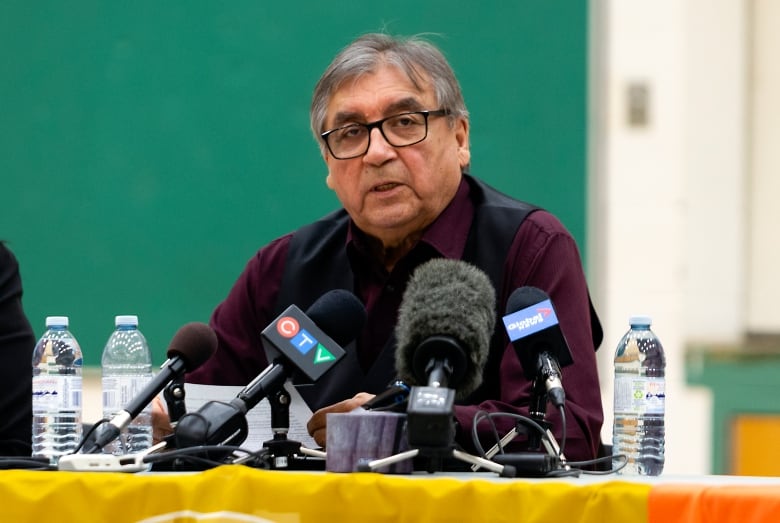Leaders of George Gordon First Nation in Saskatchewan announced Wednesday that 14 potential unmarked burial sites had been found close to the site of the former Gordon’s Indian Residential School.

WARNING: This story contains distressing details.
Leaders of George Gordon First Nation in Saskatchewan announced Wednesday that 14 potential unmarked burial sites had been found close to the site of the former Gordon’s Indian Residential School.
George Gordon First Nation’s chief and council and the band’s residential school cemetery committee announced the results of a geophysical investigation Wednesday afternoon.
Chief Byron Bitternose addressed the media, announcing the discovery of the 14 possible burial sites. He also said the search is not complete.
“In upcoming months this area will be a priority, an area for continued searching,” Bitternose said. “It is my hope that one day we will be able to tell our children the whole story of what their great-grandparents, grandparents, parents and siblings endured.”

A total of four areas within the First Nation have been searched, he said. One high-probability site was detected.
While the ground-penetrating radar (GPR) data cannot discern if the sites are graves of children, George Gordon First Nation member Sarah Longman says there is a high probability.
“The GPR machines will detect anomalies buried within the ground,” said Longman, who is also chair of the George Gordon First Nation IRS cemetery committee.
“You look for recurring patterns, so you look for patterns in similar size, similar shape and similar depths. Those pieces, those recurring patterns are the possible burial areas.”
WATCH | First Nation says 14 possible burials found at former Sask. residential school:

Sask. First Nation says 14 possible burial sites found at former residential school
WARNING: This video contains distressing details | With findings from ground-penetrating radar, George Gordon First Nation announced there are 14 potential unmarked burial sites on the grounds of a former residential school north of Regina. Officials fear more sites could be found once they complete their search — which could take years. 1:59
A prior news release from the community, located about 95 kilometres north of Regina, was scarce with details but said work was underway for months and the work was difficult.
The release said Wednesday’s announcement would include results from the first geophysical investigation.
“It’s a sad day for us, but I think we had to get here,” said Bitternose. “And it’s just the beginning.”
Search started in 2021
In 2021 George Gordon First Nation started the journey of trying to locate unmarked graves of former residential school students who never returned to their families, the chief said on Wednesday.
Last summer, a committee was formed in the community to honour the experiences, the memories, and “to acknowledge the genocide and the impact this collective legacy” has on members of the George Gordon First Nation, Bitternose said.

Four areas of interest were identified for the ground-penetrating radar work, based on the information provided by residential school survivors and descendants.
Longman said the last couple of months have only been phase one of the First Nation’s journey.
“We’ve only completed the first six months of what will probably turn into a ten year ongoing search,” she said.
“We’re dealing with 100 plus years of history of the residential school here in George Gordon. So there’s a lot of work and a lot of area to cover.”
The next step will be to expand the area of interest where the anomalies have been found, said Longman.
The National Centre for Truth and Reconciliation’s memorial for children who died or went missing at residential schools lists nearly 50 names tied to the institution at Gordon’s.
“This was a horrible residential school in terms of physical, in terms of sexual abuse,” said Eddie Bitternose, a member of George Gordon First Nation and a residential school survivor.
He attended the school in 1958 as a day scholar, he said.

The institution was established in 1876 by the Anglican Church of Canada, which operated it until 1946, when it was taken over by the Indian and Eskimo Welfare Commission and eventually the government of Canada.
Do you know of a child who never came home from residential school? Or someone who worked at one? We would like to hear from you. Email our Indigenous-led team investigating the impacts of residential schools at wherearethey@cbc.ca
It was expanded in 1888 to house students before the first rendition was destroyed by fire in 1929. It was rebuilt, but issues with water and maintenance would leave it closed again for extended periods of time between 1947 and 1953.
It would become one of the last residential schools to close in the country when it shuttered in 1996.
Chief Byron Bitternose said the parties involved in running the school in the past, including the church and the government, need to step up, sit down with the First Nation and ask how they can help.
“During this period, Indian children were apprehended and placed in the school,” he said. “Some never made it home.”
Shattering the Silence: The Hidden History of Indian Residential Schools in Saskatchewan ebook, published by the University of Regina, cites federal government documents linking a few student deaths and the decades of sexual abuse which took place at Gordon’s.
In 1993 a former employee pled guilty to charges related to sexual assaulting students at the institution’s residence between 1968 and 1984.
Support is available for anyone affected by their experience at residential schools, and those who are triggered by the latest reports.
A national Indian Residential School Crisis Line has been set up to provide support for survivors and those affected. People can access emotional and crisis referral services by calling the 24-hour national crisis line: 1-866-925-4419. A Saskatchewan-based line is now available by calling 306-522-7494.

